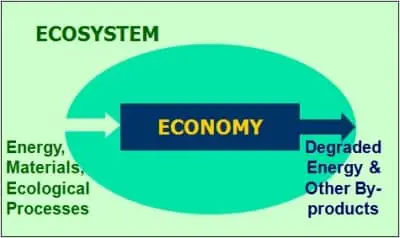This article describes the resource management perspective. Read on to find out more about this popular paradigm of human-environment interactions.
In environmental management, one of the dominant paradigms of human-environment interactions is the resource management approach. A good deal of environmental management practitioners have adopted the resource management approach as the best way forward in managing environmental and natural resources.
So what is resource management? What is the focus of this environmental management approach? I describe the idea behind this management approach in the next section.
The Foundations of Resource Management
The main idea or foundation of the resource management approach lies in the belief that natural and environmental resources should help attain the goals of humankind—to meet their goals and aspirations in life.
Resources such as land, water, labor, capital, organization and skills are used to meet human needs. It is the manner by which people use and combine whatever resources they have at their disposal to complete their goals and objectives.
What Does It Take to Efficiently Use Natural and Environmental Resources?
Under the resource management paradigm, the environmental and natural resources require certain human traits to become more efficient. Practitioners need to be equipped with a good education and should be well-informed of things going around them.
Having these tools at their disposal, they gain power over the management of their natural and environmental resources. They become more technologically equipped to address changes going their way. They gain POWER to define what should happen to environmental and natural resources at their disposal.
How can people gain these necessary elements to become more adept at resource management?
For people to get hold of resources at their disposal, political participation is a must. When people are politically active, they have more resources available to them. Thus, they wield more power in managing these resources to realize their interests.
Without power at their fingertips, people are left on the sidelines—they become marginalized. Marginalization leads to poverty because of the lack of resources to lay their hands on.
What is the Nature of Resource Management?
Resource management is goal-oriented. It results from the interaction between the different sectors of society who actively take part in the political process, as mentioned earlier. This interaction is not stagnant—it evolves as changes happen in the milieu of an advancing society spurred by technological innovations—some of which are disruptive technologies, thus life changing for many.
To understand better the interactions between the different sectors of society, there is a need to look into the patterns of access to and control of environmental and natural resources. Systematic approaches can help in unraveling the dynamics of these interactions.
Examples of such tools that clarify interactions between different sectors include systems thinking where a graphical portrayal assists the analyst in unraveling essential points or critical points that make the political process work. Systems modeling will show bottlenecks and facilitate resolutions of problematic areas.
I helped develop a new systems thinking tool to see how the different components of the environment and human actions. We call this SESAMME, an app developed to help understand how changes in one component of the ecosystem can impact human lives or vice versa.
The following video shows how SESAMME works.
SESAMME, a systems thinking tool to understand the interactions between environmental and natural resources
To make resource management work, we must organize communities to manage the resources next or accessible to them. In order to do this, a good understanding of what’s going on in the community is necessary.
This is better understood by looking into the patterns of access to and control of resources. Effective resource management in a community will not prosper unless a systematic approach is adopted. We must organize the community in order to be effective in managing fully well the resources under their care.
Why is there a Need for Resource Management?
Why is there so much fuss about managing the environmental and natural resources? Is resource management badly needed?
For all intents and purposes, there is a need for us to manage the ever continuing decline in the availability of natural resources. Human population approaches 8 billion. The human population growth requires natural resources to support. The earth is approaching its limits as evidenced by higher competition between users and the corresponding degradation of environmental and natural resources.
Thus, effective resource management is the key to greater sustainability.
Viewpoint of Resource Management
How does the resource management approach view the interactions between the environment and the economy?
The resource management approach advocates resource use efficiency. Using natural resources becomes efficient through the use of a combination of approaches like preservation or protection of natural resources, wise management through optimal use of resources at hand, and crafting policies that favor and ensure the continued existence of critical habitats or ecosystems.
Resource management looks at sustainability of resource use despite the pressures and threats of natural and anthropogenic agents. Climate change, in particular, is a major concern in the recent years. Incompatible human uses of the environment aggravate the impact of severe typhoons, hot climates, and other natural disturbances.
In relation to the economy, the resource management approach views the economy embedded in the ecosystem within which it operates. The economy extracts energy, materials, or ecological processes from the ecosystem, incorporates these inputs into the economy using technologies that shape, process, manipulate, or combine these materials into something useful to society, and returns the used items back into the environment as residuals, degraded energy, and other by-products—which when not managed correctly simply becomes pollution that threaten the integrity of the ecosystem or the environment.
We can represent this view using the following simplified diagram of the interaction between the economy and the environment:

Limitations of the Resource Management Paradigm
Although we can say that the resource management paradigm appears to be ideal, there are still issues to deal with in real-life situations. The environmental situation is so complex that a single, cure-all approach would solve current concerns to attain the goal of sustainability.
Subscribing to the idea espoused by resource management can help plan out strategies for action to the benefit of all resource users, without the need to jeopardize the future generation’s use of environmental and natural resources.
© 2023 January 24 P. A. Regoniel

